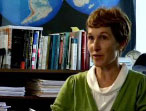 |
NASA | GSFC | JPL | Site Map |
|
|
 |
 |
Education: Student Outcomes |
Click here to search for other assets Oceanographers Will "Catch Up" Grade level: 9-12 Theme: 21st century technology Video: aquarius_catch_up.flv
But with the ocean, the ocean has been much more inaccessible. It has been inaccessible because it's very far away from where people live, it's very deep, and it's also it's very salty which means it has been a very corrosive environment for instruments. But what we're able to do now with satellite measurements is get a lot of data over large areas of space and continuously in time. And that information about the salinity, coupled with the information we have about the ocean temperatures because of the NASA satellites, really helps us learn a lot more about the ocean, and the ocean circulation. So one day we will also be able to make predictions about ocean circulation. Student Outcomes After viewing this video, students should be able to: Explain that ocean science is interdisciplinary and requires new ways of thinking. (T: 9-12) Key: C = climate / O = ocean circulation / T = 21st century technology / W = water cycle |
|||||
